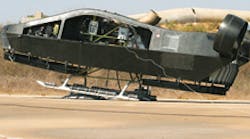|
Urban Aeronautics, For info on another hovering UAV, visit: tiny.cc/DqG25
Videos |
Engineers at Urban Aeronautics in Israel are flight testing a prototype of their latest ducted-fan-powered aircraft, an unmanned vehicle they call the Mule. It will be used by the military or civilians to deliver supplies or evacuate injured in places even helicopters can’t get to such as heavy jungles or dense urban environments.
The Mule, like many Urban Aero aircraft, is based on Fancraft, a patented approach to using ducted fans. Though ducted fans were introduced in the 1960s, they were practically abandoned because it was difficult to control them. Limited speed and sensitivity to wind gusts have been problems as well. But ducted fans are essential if aircraft are to operate in the congested airspace and environment of cities, according to Urban Aero. Ducting protects rotors from inadvertently hitting electrical wires, trees, buildings, and other aircraft.
To overcome ducted fans’ limitations, Urban Aero developed adaptable-duct airflow, which places louvres over the intake duct and at the rear of the aft duct. The louvres can be independently deflected in either direction, creating side forces and moments. This lets the Mule generate a translational movement with no rolling moment or a rolling moment with no translational movement, and gives the aircraft six degrees of freedom. It also means the UAV can take advantage of the ducts while hovering or render the ducts “transparent” to the airflow when in forward flight.
Fancraft technology also relies on high-efficiency engines, strong, light composite materials, flyby- wire and advanced autopilot control.
The turboshaft engine being evaluated on the prototype is a Turbomeca Arriel 1D1 that delivers 750 shp. This power is sent to two lift fans, each with a 1.8-m propeller, and to two smaller thrust fans through several gearboxes and drive-shafts. The 1,400-lb Mule can carry 500 lb of payload plus 500 lb of fuel at speeds to 100 knots for up to 2 hr. With smaller payloads, flight time can extend to 4 hr.
|
HELLO GEORGE JETSON THE FLYING CAR YOU’VE BEEN WAITING FOR Engineers at Urban Aeronautics are also at work refining the X-Hawk, an aircraft that can safely hover and land in congested areas without endangering itself or the environment. This aircraft can even land in a crowd of people without compromising their safety. The aircraft’s ducted-fan makes it significantly quieter and safer (no exposed rotors) than any helicopter. It is designed to meet all FAA requirements.
|
The fuselage and five-bladed, variable-pitch lift rotors are made of composites by Aerocomposites Inc. to keep weight down.
The ground-control unit that monitors all communications to and from the Mule and lets an operator remotely fly it was tested, along with the flight sensors, on the Panda, a small UAV the company makes.
The Mule should undergo hover tests this year, according to Urban Aero. But even while it’s still being tested, potential military customers are clamoring for a faster version. So the company has begun wind-tunnel testing a larger, upgraded version. It will likely be 20% larger and 50% heavier, and powered by a 1,600-shp-class turbine engine.
The faster Mule will also change its angle of attack depending on the flight regime in which it is operating. For example, while hovering, it will be relatively flat and parallel to the ground. But in cruise, it will dip its nose to let the lift fans contribute thrust.
On the downside, the upgraded Mule will be more mechanically complicated than the original, with a commensurate increase in cost and the risk of a breakdowns. And unlike the original, the upgraded version will not fit inside CH-53 and Agusta-Westland AW101 transport helicopters.
